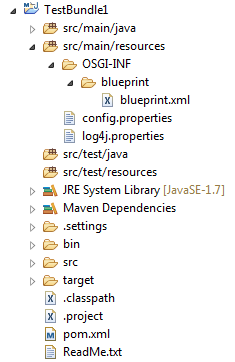Given a very simple Camel bundle for Karaf, generated with the camel-archetype-blueprint, I want to add a datasource that is configured via properties and not within the blueprint.xml.
I tried configuring a PropertiesComponent and accessing the property within the property value for the MySQL datasource in various ways, but none seems to work. When logging a message though, the properties are accessible.
How can a datasource be configured using parameter values from a properties file?
I especially need this to use the same datasource configuration for multiple bundles and distinguish between production/test environments. I thought about writing the properties with Maven during the build, depending on the target environment. Are there any other best practices on how to solve this datasource issue?
<?xml version="1.0" encoding="UTF-8"?>
<blueprint xmlns="http://www.osgi.org/xmlns/blueprint/v1.0.0"
xmlns:xsi="http://www.w3.org/2001/XMLSchema-instance"
xsi:schemaLocation="http://www.osgi.org/xmlns/blueprint/v1.0.0 http://www.osgi.org/xmlns/blueprint/v1.0.0/blueprint.xsd
http://camel.apache.org/schema/blueprint http://camel.apache.org/schema/blueprint/camel-blueprint.xsd">
<bean id="properties" class="org.apache.camel.component.properties.PropertiesComponent">
<property name="location" value="classpath:config.properties" />
</bean>
<bean id="dataSourceMySQL" class="com.mysql.jdbc.jdbc2.optional.MysqlDataSource">
<property name="url" value="jdbc:mysql://127.0.0.1/test_database" />
<!-- This causes an error, as it tries to connect with
`${mysqlUser}`@`localhost` without any evaluation -->
<property name="user" value="${mysqlUser}" />
<property name="password" value="${mysqlPassword}" />
</bean>
<service interface="javax.sql.DataSource" ref="dataSourceMySQL">
<service-properties>
<entry key="osgi.jndi.service.name" value="jdbc/mysqlDatasource" />
</service-properties>
</service>
<bean id="sql" class="org.apache.camel.component.sql.SqlComponent">
<property name="dataSource" ref="dataSourceMySQL" />
</bean>
<camelContext xmlns="http://camel.apache.org/schema/blueprint">
<route id="messageQuery">
<from uri="sql:SELECT * FROM messages" />
<log message="The user property is: {{mysqlUser}}, the query result is: ${body}" />
</route>
</camelContext>
</blueprint>
Just for an overview, the project layout looks like this:

